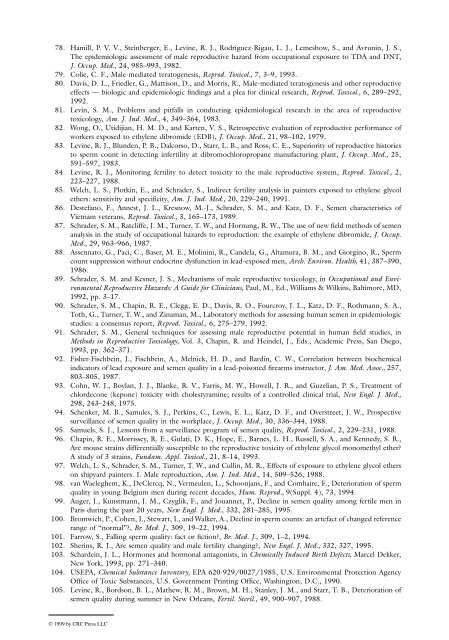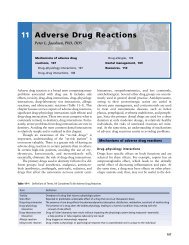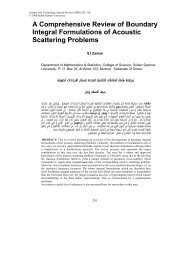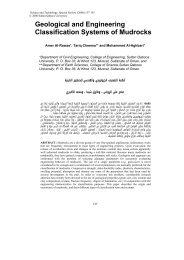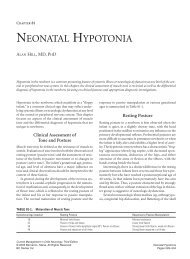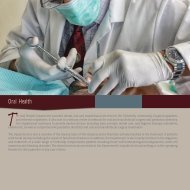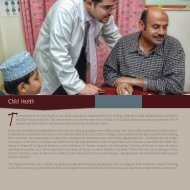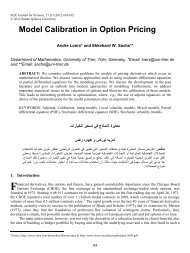Male Reproductive Toxicity - SQU Home
Male Reproductive Toxicity - SQU Home
Male Reproductive Toxicity - SQU Home
Create successful ePaper yourself
Turn your PDF publications into a flip-book with our unique Google optimized e-Paper software.
78. Hamill, P. V. V., Steinberger, E., Levine, R. J., Rodriguez-Rigau, L. J., Lemeshow, S., and Avrunin, J. S.,The epidemiologic assessment of male reproductive hazard from occupational exposure to TDA and DNT,J. Occup. Med., 24, 985–993, 1982.79. Colie, C. F., <strong>Male</strong>-mediated teratogenesis, Reprod. Toxicol., 7, 3–9, 1993.80. Davis, D. L., Friedler, G., Mattison, D., and Morris, R., <strong>Male</strong>-mediated teratogenesis and other reproductiveeffects — biologic and epidemiologic findings and a plea for clinical research, Reprod. Toxicol., 6, 289–292,1992.81. Levin, S. M., Problems and pitfalls in conducting epidemiological research in the area of reproductivetoxicology, Am. J. Ind. Med., 4, 349–364, 1983.82. Wong, O., Utidijian, H. M. D., and Karten, V. S., Retrospective evaluation of reproductive performance ofworkers exposed to ethylene dibromide (EDB), J. Occup. Med., 21, 98–102, 1979.83. Levine, R. J., Blunden, P. B., Dalcorso, D., Starr, L. B., and Ross, C. E., Superiority of reproductive historiesto sperm count in detecting infertility at dibromochloropropane manufacturing plant, J. Occup. Med., 25,591–597, 1983.84. Levine, R. J., Monitoring fertility to detect toxicity to the male reproductive system, Reprod. Toxicol., 2,223–227, 1988.85. Welch, L. S., Plotkin, E., and Schrader, S., Indirect fertility analysis in painters exposed to ethylene glycolethers: sensitivity and specificity, Am. J. Ind. Med., 20, 229–240, 1991.86. Destefano, F., Annest, J. L., Kresnow, M.-J., Schrader, S. M., and Katz, D. F., Semen characteristics ofVietnam veterans, Reprod. Toxicol., 3, 165–173, 1989.87. Schrader, S. M., Ratcliffe, J. M., Turner, T. W., and Hornung, R. W., The use of new field methods of semenanalysis in the study of occupational hazards to reproduction: the example of ethylene dibromide, J. Occup.Med., 29, 963–966, 1987.88. Assennato, G., Paci, C., Baser, M. E., Molinini, R., Candela, G., Altamura, B. M., and Giorgino, R., Spermcount suppression without endocrine dysfunction in lead-exposed men, Arch. Environ. Health, 41, 387–390,1986.89. Schrader, S. M. and Kesner, J. S., Mechanisms of male reproductive toxicology, in Occupational and Environmental<strong>Reproductive</strong> Hazards: A Guide for Clinicians, Paul, M., Ed., Williams & Wilkins, Baltimore, MD,1992, pp. 3–17.90. Schrader, S. M., Chapin, R. E., Clegg, E. D., Davis, R. O., Fourcroy, J. L., Katz, D. F., Rothmann, S. A.,Toth, G., Turner, T. W., and Zinaman, M., Laboratory methods for assessing human semen in epidemiologicstudies: a consensus report, Reprod. Toxicol., 6, 275–279, 1992.91. Schrader, S. M., General techniques for assessing male reproductive potential in human field studies, inMethods in <strong>Reproductive</strong> Toxicology, Vol. 3, Chapin, R. and Heindel, J., Eds., Academic Press, San Diego,1993, pp. 362–371.92. Fisher-Fischbein, J., Fischbein, A., Melnick, H. D., and Bardin, C. W., Correlation between biochemicalindicators of lead exposure and semen quality in a lead-poisoned firearms instructor, J. Am. Med. Assoc., 257,803–805, 1987.93. Cohn, W. J., Boylan, J. J., Blanke, R. V., Farris, M. W., Howell, J. R., and Guzelian, P. S., Treatment ofchlordecone (kepone) toxicity with cholestyramine; results of a controlled clinical trial, New Engl. J. Med.,298, 243–248, 1975.94. Schenker, M. B., Samules, S. J., Perkins, C., Lewis, E. L., Katz, D. F., and Overstreet, J. W., Prospectivesurveillance of semen quality in the workplace, J. Occup. Med., 30, 336–344, 1988.95. Samuels, S. J., Lessons from a surveillance program of semen quality, Reprod. Toxicol., 2, 229–231, 1988.96. Chapin, R. E., Morrissey, R. E., Gulati, D. K., Hope, E., Barnes, L. H., Russell, S. A., and Kennedy, S. R.,Are mouse strains differentially susceptible to the reproductive toxicity of ethylene glycol monomethyl ether?A study of 3 strains, Fundam. Appl. Toxicol., 21, 8–14, 1993.97. Welch, L. S., Schrader, S. M., Turner, T. W., and Cullin, M. R., Effects of exposure to ethylene glycol etherson shipyard painters. I. <strong>Male</strong> reproduction, Am. J. Ind. Med., 14, 509–526, 1988.98. van Waeleghem, K., DeClercq, N., Vermeulen, L., Schoonjans, F., and Comhaire, F., Deterioration of spermquality in young Belgium men during recent decades, Hum. Reprod., 9(Suppl. 4), 73, 1994.99. Auger, J., Kunstmann, J. M., Czyglik, F., and Jouannet, P., Decline in semen quality among fertile men inParis during the past 20 years, New Engl. J. Med., 332, 281–285, 1995.100. Bromwich, P., Cohen, J., Stewart, I., and Walker, A., Decline in sperm counts: an artefact of changed referencerange of “normal”?, Br. Med. J., 309, 19–22, 1994.101. Farrow, S., Falling sperm quality: fact or fiction?, Br. Med. J., 309, 1–2, 1994.102. Sherins, R. J., Are semen quality and male fertility changing?, New Engl. J. Med., 332, 327, 1995.103. Schardein, J. L., Hormones and hormonal antagonists, in Chemically Induced Birth Defects, Marcel Dekker,New York, 1993, pp. 271–340.104. USEPA, Chemical Substance Inventory, EPA 620-929/0027/1985, U.S. Environmental Protection AgencyOffice of Toxic Substances, U.S. Government Printing Office, Washington, D.C., 1990.105. Levine, R., Bordson, B. L., Mathew, R. M., Brown, M. H., Stanley, J. M., and Starr, T. B., Deterioration ofsemen quality during summer in New Orleans, Fertil. Steril., 49, 900–907, 1988.© 1999 by CRC Press LLC


